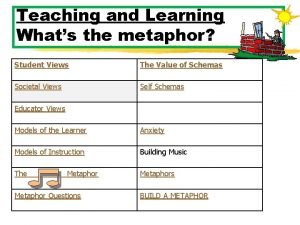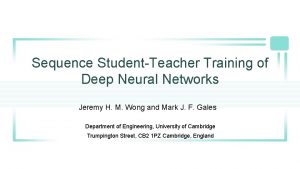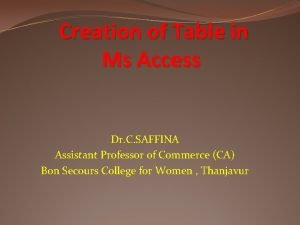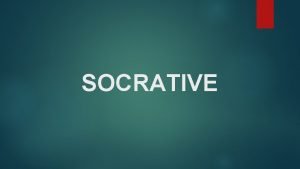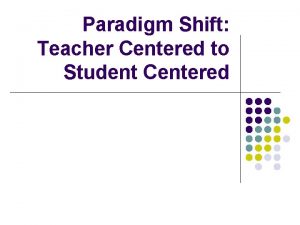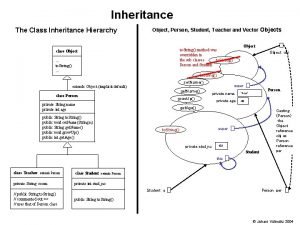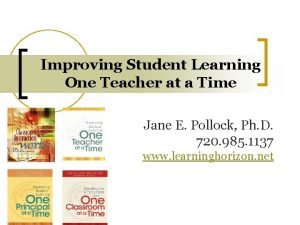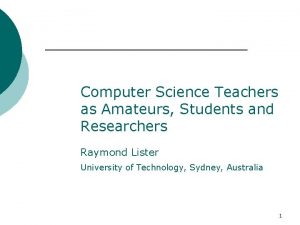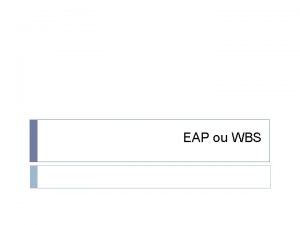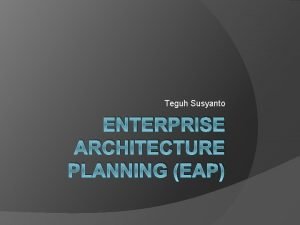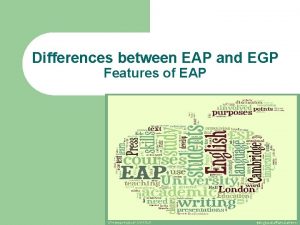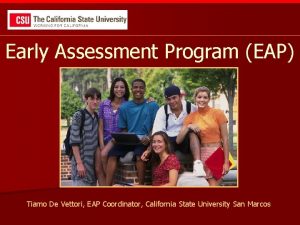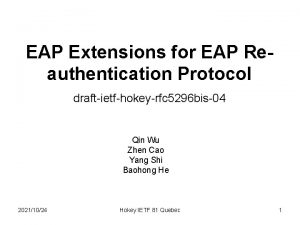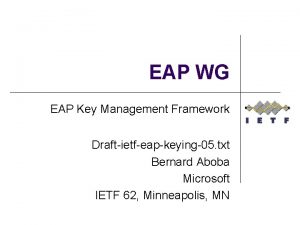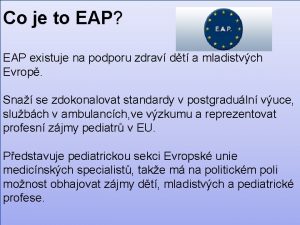THE EAP STUDENT How can the EAP teacher














- Slides: 14

THE EAP STUDENT: How can the EAP teacher cater for diverse linguistic and academic needs? Maxine Gillway Shanghai, April 2018

Framework for EAP teacher development Cai, 2017 6. Be able to conduct needs analysis, including present situation analysis(students’ wants and proficiency), and target situation analysis (the required language skills in their disciplinary studies and future careers)

BALEAP TEAP COMPETENCIES understand apply knowledge of students’ prior learning B Student experiences, their expectations, their personal, linguistic and 1 Needs academic needs and the academic literacy requirements of their target academic situation. understand the relevance of individual differences to practice B Student and the role and importance of critical thinking and autonomy in 2 Learning academic contexts and will employ tasks, processes and interactions that enable students to develop these.

REVIEW: Genre analysis = needs analysis • Identify the audience and purpose of the texts in front of you? • What are your expectations of content, organisation and language? • What are the expectations of the intended audience? • How will you find out? • Give feedback on issues of organisation and language. • Compare the learning needs identified with those of the other sample. • What common needs have you identified?

SAMPLE ISSUES 1 (487 words) 2 (318 words) 3 (482 words) 4 (308 WORDS) 5 (226 words) Grammar AGREEMENT ARTICLES AGREEMENT ARTICLES Vocabulary WORD FORM WORD CHOICE TRANSITIVITY WORD FORM WORD CHOICE PHRASE CHOICE WORD FORM WORD CHOICE Sentence structure WORD ORDER PHRASE VS CLAUSE MISSING SVO PHRASE VS CLAUSE ORDER WORD ORDER MISSING SVO WORD ORDER The n of n vs ‘s PARALLELISM PHRASE VS CLAUSE MISSING PARALLELISM Coherence or cohesion MAP NOT FOLLOWED MISSING LINK MISPLACED RELATIVE CLAUSE MISPLACED (EXTRA INFO) LINK BETWEEN PARAGRPAHS GIVEN NEW MAP NOT FOLLOWED FRONTING Conventions CITATION VISUALS ACRONYMS DIFFERENTIATION BY TASK/TIME/GROUPING: Which is the most challenging text? Why? 6 (520 words)

GRAMMAR • Subject verb agreement eg this review only concentrate on…; graphene still need to be… • Poor choice of relative prounoun eg transistors who… • Verb form eg families have attract most attention • Missing plural marker after quantifiers eg more type; various structure • Definite articles eg ‘the accurate positioning is needed’ General vs specific; first mention vs shared knowledge

VOCABULARY (use corpora eg Word and Phrase) • Word choice (from thesaurus) eg remarkable vs noticeable vs significant; asked vs required vs demanded; regards vs concerns; ability vs capacity; proper vs appropriate • Word choice in collocations eg progress/results done; research operated; represent degradation ; make conclusions of • Word form (n vs adj/ n vs v) eg Physics vs physical; fabricate vs fabrication performances vs performs; higher efficiency use vs more efficient use; transparent vs transparency • (including inventions eg nucleary) • Choice of functional exponent eg due to vs resulting from • Word grammar eg transitivity: realize vs be realized; countability: research; gradability: most key; dependent prepositions • Lack of precision eg somehow; changed a lot vs transformed • Style eg get; as well; attracts attention vs generates interest; no doubt

SENTENCE STRUCTURE • Attempted noun phrases eg the existence conditions for them are… • Teach ‘the noun of noun’ pattern • Word order within clauses eg but exist weak forces; meet almost any vs almost meet any • Clause order – fronting for emphasis or coherence (given, new) • While it lacks…. , it has…. VS It has…. while it lacks…. • Wrong choice of functional exponent eg for instance vs such as • Introducing clauses vs phrases eg with vs while + ing; prep + ing • Sentence fragments • Set phrases eg ‘when it comes to … • Structural parallelism (n, n, and n; v, v, and v)

COHERENCE and COHESION • Not following the order of points given in initial map graphene, CNTs, phosphorene, TMDs listed in introduction (I, 2, 3, 4) but paragraph order = CNTs, graphene, TMDs, phosphorene (2, 1, 4, 3) • Part of comparison lost in text eg similar properties (to what? ) • Something mentioned at the start of a previous paragraph • Misplaced embedded clauses eg , … , -…. - …. (…)…. (often adverbials) • Witheld main idea (TS at end not start of para/text) DEDUCTIVE • Clause order (theme, rheme) Topic, comment/Given, new

CONVENTIONS • Format of in-test citations • Explanation of acronyms • In-text references to figures (visual summaries)

EGP vs EGAP vs ESAP • How many of the needs are typically part of an EGP syllabus? • How many of the needs are discipline specific?

ASSESSMENT FEEDBACK • Look at the extracts of feedback given by the intended audience. • What was the purpose? • Were there any bad choices of content? • Were there any bad choices of organisation? • Were there any bad choices of language? • What needs do the positive comments indicate?

Example Feedback analysis I think you answer the question pretty well. You've picked a key development and explored a number of aspects of it with examples. I think you could have focussed more tightly on the specific properties of SPIONS in your analysis and critical analysis is a little lacking. The key place where you do attempt this is the (very important and interesting) question of why these approaches are not in widespread clinical use. I actually think you could have explored this question in more depth (if some of the overwhelming detail in other areas had been cut - see above) and done so from several perspectives. You hint at these but the discussion is quite short and I feel I lost out a bit. Nevertheless, generally good.

DESIGN DECISIONS Having diagnosed student needs from their work and the assessment feedback on that work – 1) What would you include in a short course for nanoscientists? Why? see SOW 2) What would you focus on in a tutorial with your student writer? Why? ask them to ask you – set up a dialogue 3) What would you include in a session for a mixed discipline group? Why? coherence and cohesion – most problematic re FB 4) How could you differentiate for different student needs? task, time, grouping (personal checklists)
 Good morning, students.
Good morning, students. Erf form
Erf form Good morning message to my lecturer
Good morning message to my lecturer Metaphor teacher-student relationship
Metaphor teacher-student relationship Student teacher neural network
Student teacher neural network Direct method learning
Direct method learning Teacher student database example
Teacher student database example Every student deserves a great teacher
Every student deserves a great teacher Improving student learning one teacher at a time
Improving student learning one teacher at a time Www.socrative.com student login
Www.socrative.com student login Paradigm shift teacher-centered to student-centered
Paradigm shift teacher-centered to student-centered Student teacher
Student teacher Improving student learning one teacher at a time
Improving student learning one teacher at a time Amateur teacher student
Amateur teacher student Greek philosopher plato teacher
Greek philosopher plato teacher



